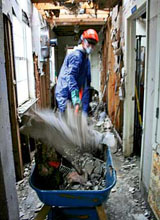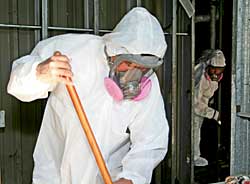
After the Deluge: Outfitting Cleanup Crews
Increasing hurricane activity means a continuing need for respiratory protection.
- By Paul Puncochar, CIH
- May 08, 2007
 WHEN Hurricane Katrina slammed ashore in 2005, it helped drive home the fact that intense hurricanes are becoming a constant concern for residents along the Gulf Coast and Florida coastal regions.
WHEN Hurricane Katrina slammed ashore in 2005, it helped drive home the fact that intense hurricanes are becoming a constant concern for residents along the Gulf Coast and Florida coastal regions.
While no hurricane touched the U.S. coastline in 2006, that unusual respite is not likely to be repeated this year, according to a forecast issued by Colorado State University's forecasting team. The El Nino weather conditions that led to a quiet Atlantic hurricane season in 2006 will probably dissipate by summer, leading to above-average hurricane activity for 2007. Fourteen named storms are forecast spawning seven hurricanes, at least three of which will be intense. According to forecasters, at least one of the three will make U.S. landfall.
While some debate continues over the cause of increased hurricane activity, there is little question that warming waters in the Atlantic are fueling the storms. In 2006, sea surface temperatures of Atlantic waters, where many hurricanes form, were a record 1.7 degrees above the 1901-1970 average.
According to a recent study by the National Center for Atmospheric Research (NCAR), global warming accounted for about half of the hurricane-fueling warmth in Atlantic waters, while natural cycles were a smaller factor.
Response to Hurricanes Katrina and Rita
The double whammy inflicted on the Gulf Coast by Hurricanes Katrina and Rita in 2005 elicited an unprecedented outpouring of money from federal sources and private donations. In the first six months alone, the federal government committed more than $88 billion to cleanup and recovery efforts.
Volunteerism, too, is at an all-time high. For example, AmeriCorps has coordinated the efforts of thousand of college students who have spent their spring breaks laboring in the water-damaged buildings and debris piles that litter the 90,000 square miles affected by the storms. In addition, volunteers from hundreds of churches and other organizations have devoted untold hours helping with the continued cleanup and rebuilding. In one community alone, Pass Christian, Miss., 700 AmeriCorps volunteers donated an estimated 200,000 hours of service in the six months following the storm.
The Pass Christian experience is typical of those communities taking a direct hit from Katrina. Its destruction at the hands of the hurricane was almost complete. The 145 mph winds and 30-foot high sea surge storming ashore left 100 percent of the businesses and 75 percent of the homes destroyed or rendered uninhabitable.
The good news and bad news is that levels of volunteerism are so high. It's good news because there is so much work to be done. The bad news is that it so difficult to ensure that all of the thousands of volunteers, coming and going as they do for one- or two- week stints, have proper respiratory protection. Companies that manufacture respirators have worked to help volunteers and cleanup workers. 3M Sales Representatives Ronnie Pearson and Rhett Harris, for example, were traveling the region even before the floodwaters subsided, offering train-the-trainer seminars on fit testing and providing advice on equipment selection and use.
Professional contract cleaners face yet another set of problems. The need for cleaners is so great that "training and fit testing is a constant need. And our turnover rate is very high," said Kim Kornfeld, field manager for Nationwide Restoration.
Respiratory Hazards1,2
The following information is intended to provide a general overview of potential inhalation hazards during hurricane cleanup. It is not intended to present every respiratory hazard exposure that may occur. A comprehensive exposure assessment conducted by a qualified health and safety professional is recommended prior to undertaking work in hurricane-affected areas. Use of a properly qualified contractor to handle and remove common cleanup hazards may be necessary to minimize exposures and resulting adverse health effects.
Mold
According to a report by the American Society of Safety Engineers, there are many physical hazards facing cleanup workers. One main focus of ASSE’s six-month Katrina overview was mold remediation. "During their week's visit to the region, the authors saw many demolition workers in compromised work sites, but few of these workers wore a respirator."
The aftermath of a hurricane can create optimal conditions for mold growth. Molds are a type of fungus that can grow and live in organic matter where moisture is present, including many building materials. Subsequent to water damage, mold may
begin to grow on a variety of building materials and surfaces, both in open and hidden locations.
Molds reproduce by means of tiny spores. The spores are invisible to the naked eye and become easily airborne and may enter the lungs. Disturbing mold in any manner will result in higher air concentrations. Molds also can release low levels of volatile organic compounds (VOCs) that are thought to be the source of mold/mildew odors.
Exposure to molds can result in mild to severe health problems, depending on the individual. An allergic response is the most common health effect associated with exposures. Symptoms may include sneezing, runny nose, eye irritation, cough, congestion, and dermatitis. Susceptible individuals, such as those with asthma, hypersensitivity pneumonitis, severe allergies, immune suppression, or other chronic inflammatory lung diseases, may be more sensitive to molds.3
Hidden respiration hazards
Other inhalation hazards to be aware of during hurricane cleanup include:
• Exposure to asbestos and lead, especially in older buildings.
• Exposure to crystalline silica present naturally and in pulverized concrete.
• Releases of petroleum and other hazardous substances from underground and above-ground storage tanks.
• Carbon monoxide generated when using fuel-burning devices, such as gasoline- powered generators and pressure washers, camp stoves and lanterns, or charcoal grills in homes, garages, or other confined areas.
• Soils containing low volatility hazardous chemicals such as polychlorinated biphenyls (PCBs), pesticides, and metals. These chemicals tend to remain in the soil for long periods of time and become airborne when disturbed.
• Infectious disease in areas where floodwaters contain sewage or decaying animal and human remains. Standing water is a breeding ground for microorganisms that can become airborne during cleanup activities, such as pumping/aeration of floodwater.
• Cleaners and disinfectants used to wash dirty surfaces, particularly if used in confined areas.
Considerations for Respirator Selection
The general approach to respirator selection requires knowledge of the specific contaminant, the air concentration, and the occupational exposure limit. In the case of mold, lack of recognized exposure limits requires use of other criteria in the selection process. The U.S. Environmental Protection Agency and the New York City Department of Health have published recommendations for selecting respirators for mold remediation activities based upon the size of the contaminated area.4
EPA offers the following general guidelines for respirator selection:
• For areas less than 10 square feet, an N95 filtering facepiece respirator approved under 42 CFR Part 84 may be used in combination with non-vented goggles.
• For areas between 10 and 100 square feet, either a half mask with non-vented goggles or a full-facepiece respirator with 100 level particulate filters (e.g., P100) should be used.
• For areas greater than 100 square feet, a full-facepiece respirator with 100 level particulate filters should be used.
Professional judgment that considers toxicity of the mold (if known), possibility of hidden mold, potential for aerosolization, and needs of the wearer also should be used when selecting respiratory protection.
For low-level microbial VOCs produced by mold, a carbon-loaded particulate filter offering nuisance-level organic vapor relief or an organic vapor cartridge used with a particulate filter also may be used. Gases and vapors associated with disinfectants (chlorine, chlorine dioxide, ammonia, etc.) should be measured and may also warrant the use of a chemical cartridge with particulate filter. Respirator selection for other potential air contaminants must also be considered. In many cases, respirators used for mold exposures may be used for other anticipated contaminants.
Consistent with current respiratory selection practices, the following additional guidelines are offered when selecting respiratory protection for hurricane cleanup applications:
• A 42 CFR Part 84 approved N-Series particulate filter (e.g., N95, N100) may be used where no oil aerosols are present.
• An R-Series or P-Series particulate filter may be used for both oil and non-oil aerosols. When used for oil aerosols, refer to the manufacturer's product packaging for time use limitations.
• Dusts containing asbestos require a minimum of a half-facepiece reusable respirator with a 100 level particulate filter. OSHA prohibits use of filtering facepiece respirators (disposables) for asbestos.
• Dusts containing lead require a minimum of a 100-level filtering facepiece respirator or half-facepiece respirator with 100-level particulate filters.
• A filtering facepiece respirator or half-facepiece respirator with appropriate cartridges/filters may be used up to 10X the Permissible Exposure Limit (PEL).
Respirator Use Training
Individuals participating in hurricane cleanup efforts represent a diverse group, including both professional workers and volunteers. Their knowledge and experience in the use of respiratory protection may vary significantly. At minimum, a basic understanding of respirators is essential for everyone prior to initial use. For professional workers falling under the scope of OSHA, specific regulatory requirements are mandatory.
Employers using respiratory protection must comply with all requirements of 29 CFR 1910.134, Respiratory Protection Standard--including, but not limited to, medical evaluations, training, and fit testing prior to using respirators. Fit testing provisions require that all workers wearing a tight-fitting, half-, or full-facepiece respirator must pass a quantitative or qualitative fit test to ensure an adequate face-to-respirator seal in achieved. The medical evaluation, used to determine whether the person is physically able to wear a respirator, must be completed prior to the fit test. Respirator training must be completed at least annually.
Volunteers who don't necessarily have access to respirator training and fit testing programs should, at a minimum, be given basic information on the use and limitations of respirators. Volunteers also should be prohibited from working in areas where exposures are above the PEL and should be required to use respirators.
The following guidelines are offered for non-occupational users of respirators during hurricane cleanup:
• Volunteers should check with the organization/agency to determine whether it has a respirator program for volunteers. If not providing respirators, ask whether the organization can recommend an appropriate respirator for the anticipated work. The respirator manufacturer should be contacted if assistance is needed in selecting a respirator.
• Wearing a respirator adds physical stress in the form of additional weight and increased breathing resistance. Volunteers with doubts concerning their ability to wear a respirator should contact a physician to discuss the type of work, the respirator intended for use, and the anticipated contaminants.
• The manufacturer's instructions should be followed for proper respirator donning and doffing procedures. A user seal check is required each time the respirator is worn. The volunteer also should check instructions to determine whether there is any time use limitation for the respirator.
• If wearing a reusable half-facepiece or full-facepiece respirator, the user should follow the respirator manufacturer's recommendations for cleaning. Daily cleaning typically is recommended.
Other work-specific conditions including work rate, physical condition, ambient temperature, and humidity also should be considered when making a personal decision to wear a respirator.
References
1. NIOSH, www.cdc.gov/niosh/topics/flood/
2. USEPA, www.epa.gov
3. OSHA Fact Sheet, Mold, www.osha.gov
4. "Mold Remediation in Schools and Commercial Buildings," 2001, USEPA.
"Guidelines on Assessment and Remediation in Indoor Environments," 2000.
NYC Dept. of Health, Bureau of Environmental & Occupational Disease Epidemiology.
This article originally appeared in the May 2007 issue of Occupational Health & Safety.